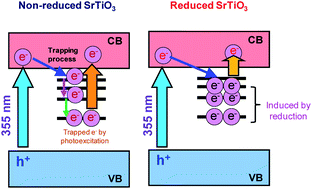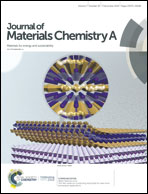Crucial impact of reduction on the photocarrier dynamics of SrTiO3 powders studied by transient absorption spectroscopy†
Abstract
Inducing oxygen vacancy defects in SrTiO3 powders via high temperature treatment in the presence of a mixture of Ar, O2, dry air, and H2 ambient gases is a promising strategy to produce homogeneously defective SrTiO3 photocatalysts with a remarkable 40-fold enhancement of H2 evolution activity. Electron doping of SrTiO3 due to oxygen vacancies triggers the development of a highly active SrTiO3 photocatalyst; however, the photodynamic processes involved in these modifications of SrTiO3 have not been fully elucidated yet. In this work, we investigated the impact of high temperature treatment based on the dynamics of photocarriers by transient absorption spectroscopy (TAS). TAS results revealed that upon band gap excitation of SrTiO3, most of the photoexcited electrons in non-reduced SrTiO3 are deeply trapped in the intrinsic defects as evident from the strong broad absorption signals peaking at 11 000 cm−1 (909 nm, 1.36 eV) and 20 000 cm−1 (500 nm, 2.48 eV), whereas the absorption intensities in this wavenumber region largely decreased in highly reduced SrTiO3, suggesting a possible electron filling of deeply trapped states via reduction treatment (or electron doping). Interestingly, the photoexcited electrons in oxygen-deficient SrTiO3 preferably occupy the shallower electron traps. The lowest energy limit of the electron trap filled by photoexcited electrons is estimated to be at the absorption edge located at 1000 cm−1 (∼0.12 eV below the conduction band), which is much shallower than that of non-reduced SrTiO3 (>0.7 eV). Furthermore, it was found that the electron population in the shallow traps in highly reduced SrTiO3 is nearly 2 orders of magnitude higher compared to that in non-reduced SrTiO3, indicating a large improvement in the electron lifetime. The findings herein offer significant insights into the crucial impact of the reduction of SrTiO3via induced oxygen vacancy defects to provide available photoexcited electrons that can be readily utilized for the H2 generation reaction.



 Please wait while we load your content...
Please wait while we load your content...